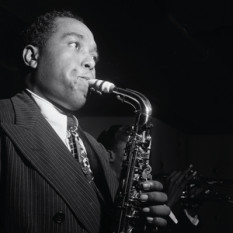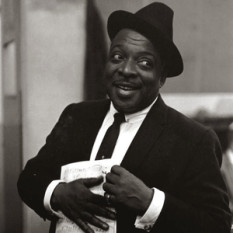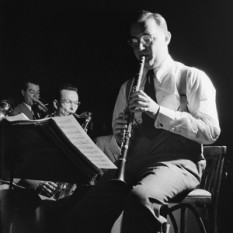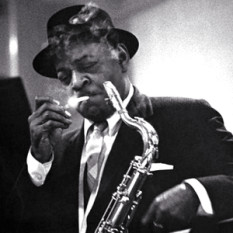Duke Ellington (Edward Kennedy Ellington, April 29, 1899 - May 24, 1974) was an American jazz composer, pianist and bandleader, one of the most influential figures in jazz, if not in all American music.
Duke Ellington composed over 3000 songs, including: "It Don't Mean A Thing If It Ain't Got That Swing", "Sophisticated Lady", "Mood Indigo", “Solitude", "In a Mellotone", and "Satin Doll".
Through the ranks of Duke Ellington & His Orchestra passed some of the biggest names in jazz, including Billy Strayhorn, Johnny Hodges, Cootie Williams, Bubber Miley, Barney Bigard, Ben Webster, Harry Carney, Sonny Greer, Otto Hardwick, Clark Terry, Jimmy Blanton, Ray Nance, Paul Gonsalves, and Wellman Braud. Many musicians stayed with him for decades. And while all of them were remarkable in their own right, and they all would have probably made it into the annals of jazz history no matter who they played for, it was Ellington's genius as a composer, pianist, bandleader, celebrity personality, and, most importantly, arranger, that made them the most incredible orchestral unit in the history of jazz. His ability to write and arrange for personalities, rather than instruments, made every solo and every section of every arrangement breathe with character. A giant on the 20th century American cultural scene, Duke Ellington was widely regarded as a legend during his own lifetime.
Early life
Edward Kennedy Ellington was born on April 29, 1899 to James Edward Ellington and Daisy Kennedy Ellington. They lived with his maternal grandparents at 2129 Ward Place, NW in Washington, D.C., USA.
James Edward Ellington was born in Lincolnton, North Carolina on April 15, 1879 and moved to Washington, D.C. in 1886 with his parents. Daisy Kennedy, was born in Washington, D.C. on January 4, 1879, and was the daughter of a former American slave. J.E. made blueprints for the United States Navy. He also worked as a butler for Dr. Middleton F. Cuthbert, a prominent white physician, and occasionally worked as a White House caterer. Daisy and J.E. were both piano players—she playing parlor songs and he operatic airs.
At the age of seven, Ellington began taking piano lessons from Mrs. Marietta Clinkscales. Daisy surrounded her son with dignified women who reinforced his manners and taught him to live elegantly. From his father, he absorbed self-confidence. Ellington’s childhood friends noticed that "his casual, offhand manner, his easy grace, and his dapper dress gave him the bearing of a young nobleman", and began calling him Duke. Ellington credited his "chum" Edgar McEntree, "a sharp dresser himself," with the nickname. "I think he felt that in order for me to be eligible for his constant companionship, I should have a title. So he called me Duke."
Though Ellington took piano lessons, he was more concerned with baseball. "President Roosevelt (Teddy) would come by on his horse sometimes, and stop and watch us play," he recalled. Ellington went to Armstrong Technical High School in Washington, D.C. He got his first job selling peanuts at Washington Senators’ baseball games where he conquered his stage fright.
In the summer of 1914, while working as a soda jerk at the Poodle Dog Café, he wrote his first composition, "Soda Fountain Rag" (also known as the "Poodle Dog Rag"). Ellington created "Soda Fountain Rag" by ear, because he had not yet learned to read and write music. "I would play the 'Soda Fountain Rag' as a one-step, two-step, waltz, tango, and fox trot," Ellington has recalled. "Listeners never knew it was the same piece. I was established as having my own repertoire." In his autobiography, Music is my Mistress, (1973) Ellington comments he missed more lessons than he attended, feeling at the time that playing the piano was not his talent. Over time, this would change. Ellington started sneaking into Frank Holiday's Poolroom at age fourteen. Hearing the poolroom pianists play ignited Ellington's love for the instrument and he began to take his piano studies seriously.
Ellington began listening to, watching, and imitating ragtime pianists, not only in Washington, D.C., but also in Philadelphia and Atlantic City, where he vacationed with his mother during the summer months.[citation needed] Dunbar High School music teacher Henry Lee Grant gave him private lessons in harmony. With the additional guidance of Washington pianist and band leader Oliver "Doc" Perry, Ellington learned to read sheet music, project a professional style, and improve his technique. Ellington was also inspired by his first encounters with James P. Johnson and Luckey Roberts, early jazz piano giants. Later in New York he took advice from Will Marion Cook, Fats Waller, and Sidney Bechet. Ellington started to play gigs in cafés and clubs in and around Washington, D.C. and began to realize his love for music. His attachment grew to be so strong that he turned down an art scholarship to the Pratt Institute in Brooklyn in 1916. He dropped out of Armstrong Manual Training School, where he was studying commercial art, just three months shy of graduation.
From 1917 through 1919, Ellington launched his musical career, painting commercial signs by day and playing piano by night. Duke's entrepreneurial side came out when if a customer would ask him to make a sign for a dance or party, he would ask them if they had musical entertainment, if not Ellington would ask if he could play for them. He also had a messenger job with the U.S. Navy and State Departments. Ellington moved out of his parents' home and into one which he bought for himself as he became a successful ragtime, jazz, and society pianist. At first, he played in other ensembles, and in late 1917 formed his first group, "The Duke’s Serenaders" ("Colored Syncopators", his telephone directory advertising proclaimed)[citation needed]. He was not only a member, but also the booking agent. His first play date was at the True Reformer's Hall where he took home 75 cents.
Ellington played throughout the Washington, D.C. area and into Virginia for private society balls and embassy parties. The band included Otto Hardwick, who switched from bass to saxophone; Arthur Whetsol on trumpet; Elmer Snowden on banjo; and Sonny Greer on drums. The band thrived, performing for both African-American and white audiences, a rarity during the racially divided times.[citation needed]
Marriage and family
With his career taking off, Ellington felt secure enough to marry his high school sweetheart, Edna Thompson, on July 2, 1918 when he was 19. Shortly after their marriage, on March 11, 1919 Edna gave birth to their only son, Mercer Kennedy Ellington, who went on to play trumpet, lead his own band and work as the road manager of his father's band, eventually taking it over after Duke's death. He was an important archivist of his father's musical life. Ellington's sister, Ruth, later ran Tempo Music, Ellington's music publishing company.
Ellington's granddaughter Mercedes is a dancer who has performed in network television productions. Grandson Paul Ellington is a pianist and composer who now leads the Duke Ellington Orchestra.
Early career
When his drummer Sonny Greer was invited to join the Wilber Sweatman Orchestra in New York City, Ellington made the fateful decision to leave behind his successful career in Washington, D.C. and aspire to the challenge of Harlem. The 'Harlem Renaissance' was in progress. New dance crazes, like the Charleston, were bred there as well as African-American musical theater, including Eubie Blake's Shuffle Along. After the young musicians left the Sweatman Orchestra to strike out on their own, they found an emerging jazz scene that was highly competitive and hard to crack. They hustled pool by day and played whatever gig they could find. The young band met Willie "The Lion" Smith who showed them the scene and even gave them spare cash. They played at rent-house parties to get by. After a few months, the young musicians returned to Washington, D.C. feeling discouraged.
But in June 1923, a gig in Atlantic City, New Jersey led to a play date at the prestigious Exclusive Club in Harlem, followed in September 1923 by a move to the Hollywood Club, 49th and Broadway, and a four-year engagement which gave Ellington a solid artistic base. The group was called Elmer Snowden and his Black Sox Orchestra and had seven members, including James "Bubber" Miley, a trumpeter whose growling style changed the "sweet" dance band sound of the group to one that was edgier and hotter. They renamed themselves "The Washingtonians". When Snowden left the group in early 1924, Ellington took over as bandleader. After a fire, the club was re-opened as the Club Kentucky (often referred to as the "Kentucky Club"), an engagement which set the stage for the biggest opportunities in Ellington's life.
Ellington made eight records in 1924, receiving composing credit on three including Choo Choo. In 1925, Ellington contributed four songs to Chocolate Kiddies, an all-African-American revue which introduced European audiences to African-American styles and performers. "Duke Ellington and his Kentucky Club Orchestra" grew to a ten-piece organization, developing their distinct sound, displaying the non-traditional expression of Ellington’s arrangements, the street rhythms of Harlem, and the exotic-sounding trombone growls and wah-wahs, high-squealing trumpets, and sultry saxophone blues licks of the band members. For a short time, the great soprano saxophonist Sidney Bechet played with the group, imparting his propulsive swing and superior musicianship on the young band members. This helped attract the attention of some of the biggest names of jazz, including Paul Whiteman.
In 1927, King Oliver turned down a regular booking for his group as the house band at Harlem's Cotton Club; the offer passed to Ellington. With a weekly radio broadcast and famous clientèle nightly pouring in to see them, Ellington and his band thrived in the period from 1932 to 1942, a "golden age" for the poor boys from Washington D.C.
Trumpeter Bubber Miley was a member of the orchestra for only a short period but had a major influence on Ellington's sound.[citation needed] An early experimenter in jazz trumpet growling, Miley is credited with morphing the band's style from rigid dance instrumentation to a growling 'jungle' style. He also composed most of "Black and Tan Fantasy" and "Creole Love Call". An alcoholic, Miley had to leave the band before they gained wider fame. He died in 1932 at the age of twenty-nine. He was an important influence on Cootie Williams, who replaced him.
In 1927 Ellington made a career-advancing agreement with agent-publisher Irving Mills giving Mills a 45% interest in Ellington's future. The brash, shrewd Mills had an eye for new talent and early on published compositions by Hoagy Carmichael, Dorothy Fields, and Harold Arlen. During the 1930s, Ellington's popularity continued to increase, largely as a result of the promotional skills of Mills, who got more than his fair share of co-composer credits. Mills arranged recording sessions on the Brunswick, Victor, and Columbia labels which gave Ellington popular recognition. Mills took the management burden off of Ellington's shoulders, allowing him to focus on his band's sound and his compositions.[citation needed] Ellington ended his association with Mills in 1937, although he continued to record under Mills' banner through 1940.
At the Cotton Club, Ellington's group performed all the music for the revues, which mixed comedy, dance numbers, vaudeville, burlesque, hot music, and illegal alcohol. The musical numbers were composed by Jimmy McHugh and the lyrics by Dorothy Fields (later Harold Arlen and Ted Koehler), with some Ellington originals mixed in. Weekly radio broadcasts from the club gave Ellington national exposure. In 1929, Ellington appeared in his first movie, a nineteen-minute all-African-American RKO short, Black and Tan, in which he played the hero "Duke". In the same year, The Cotton Club Orchestra appeared on stage for several months in Florenz Ziegfeld's Show Girl, along with vaudeville stars Jimmy Durante, Eddie Foy, Jr., Al Jolson, Ruby Keeler, and with music and lyrics by George Gershwin and Gus Kahn. That feverish period also included numerous recordings, under the pseudonyms "Whoopee Makers", "The Jungle Band", "Harlem Footwarmers", and the "Ten Black Berries". In 1930, Ellington and his Orchestra connected with a whole different audience in a concert with Maurice Chevalier and they also performed at the Roseland Ballroom, "America's foremost ballroom". Noted composer Percy Grainger was also an early admirer and supporter.
In 1929, when Ellington conducted the orchestra for Show Girl, he met Will Vodery, Ziegfeld’s musical supervisor. In his 1946 biography, Duke Ellington, Barry Ulanov wrote: “From Vodery, as he (Ellington) says himself, he drew his chromatic convictions, his uses of the tones ordinarily extraneous to the diatonic scale, with the consequent alteration of the harmonic character of his music, its broadening, The deepening of his resources. It has become customary to ascribe the classical influences upon Duke - Delius and Debussy and Ravel - to direct contact with their music. Actually his serious appreciation of those and other modern composers, came after his meeting with Vodery.” Ulanov, Barry. Duke Ellington, Creative Age Press, 1946.
As the Depression deepened, the recording industry took a dive, dropping over 90% by 1933. Ellington and his orchestra survived the hard times by taking to the road in a series of tours. Radio exposure also helped maintain his popularity. Ivie Anderson was hired as their vocalist (Sonny Greer had been providing occasional vocals). Normally, Ellington led the orchestra by conducting from the keyboard using piano cues and visual gestures; very rarely did he conduct using a baton. As a bandleader, Ellington was not a strict disciplinarian but he maintained control of his orchestra for decades to come with a crafty combination of charm, humor, flattery, and astute psychology. A complex, private person, he revealed his feelings to only his closest intimates and effectively used his public persona to deflect attention away from himself.
While their United States audience remained mainly African-American in this period, the Cotton Club had a near exclusive white clientèle and the band had a huge following overseas, demonstrated both in a trip to England in 1933 and a 1934 visit to the European mainland. The English visit saw Ellington win praise from members of the "serious" music community, including composer Constant Lambert, which gave a boost to his aspirations to compose longer "serious" pieces. And for agent Mills, it was a publicity triumph, as Ellington was now "internationally famous". On their tour through the segregated South in 1934, they avoided some of the traveling difficulties of African-American musicians by touring in private railcars, which provided easy accommodations, dining, and storage for equipment, while avoiding the indignities of segregated facilities.
The death of Ellington's mother in 1935 led to a temporary slump in his career. Competition was also intensifying[citation needed], as African-American and white "Swing Bands" began to rocket to popular attention, including those of Benny Goodman, Tommy Dorsey, Jimmy Dorsey, Jimmie Lunceford, Benny Carter, Earl Hines, Chick Webb, and Count Basie. Swing dancing became a youth phenomenon, particularly with white college audiences, and "danceability" drove record sales and bookings. Jukeboxes proliferated nationwide spreading the gospel of "swing". Ellington band could certainly "swing" with the best of them, but Ellington's strength was mood and nuance, and richness of composition, hence his statement "jazz is music; swing is business". The challenge for Ellington at that time was to create a workable balance between his ceaseless artistic exploration and the popular requirements of that era.[citation needed] Ellington countered with two innovations. He made recordings for smaller groups (sextets, octets, and nonets) drawn from his then 15-man orchestra and he composed pieces that were concerto-like and focused on a specific instrumentalist, as with Jeep's Blues for Johnny Hodges and Yearning for Love with Lawrence Brown.
In 1937, Ellington returned to the Cotton Club which had relocated to the mid-town theater district. In the summer of that year, his father died, and due to many expenses Ellington's financial condition was tight. Things improved in 1938 and he met and moved in with Cotton Club employee Beatrice "Evie" Ellis. After splitting with agent Irving Mills, he signed on with William Morris. The 1930s ended with a very successful European tour just as World War II loomed.
Ellington delivered some huge hits during the 1930s, which greatly helped to build his overall reputation "Mood Indigo" in 1930, "It Don't Mean a Thing (If It Ain't Got That Swing)" in 1932, "Sophisticated Lady" in 1933, "In a Sentimental Mood" in 1935, "Caravan" in 1937, "I Let A Song Go Out Of My Heart" in 1938. Following shortly were "Do Nothing Till You Hear from Me" in 1940 and "Take the "A" Train" (written by Billy Strayhorn) in 1941.
The most important event of Ellington’s “golden age” was the arrival of Billy Strayhorn.[citation needed] Hired as a lyricist, Strayhorn , nicknamed "Swee' Pea" for his mild manner, eventually became a vital member of the Ellington Organization and as Ellington described him, "my right arm, my left arm, all the eyes in the back of my head, my brain waves in his head, and his in mine". Strayhorn, with his Classical music training, applied that knowledge to arrange and polish future Ellington works. Ellington came to rely on Strayhorn's harmonic judgment, discipline, and taste.
Duke in the 1940s
The band reached a creative peak in the early 1940s[citation needed], when Ellington wrote for an orchestra of distinctive voices and displayed tremendous creativity. In November 1943 Ellington debuted Black, Brown and Beige in Carnegie Hall which told the struggle of African-Americans, and began a series of concerts ideally suited to displaying Ellington's longer works. While some jazz musicians had played at Carnegie Hall before, few had performed anything as elaborate as Ellington’s work. Some of the musicians created a sensation in their own right. The short-lived Jimmy Blanton transformed the use of double bass in jazz, allowing it to function as a solo rather than a rhythm instrument alone. Ben Webster too, the Orchestra's first regular tenor saxophonist, started a rivalry with Johnny Hodges as the Orchestra's foremost voice in the sax section. Ray Nance joined, replacing Cootie Williams who had "defected", contemporary wags claimed, to Benny Goodman. Nance, however, added violin to the instrumental colors Ellington had at his disposal. A privately made recording of Nance's first concert date, at Fargo, North Dakota, in November 1940, is probably the most effective display of the band at the peak of its powers during this period. This recording is one of the first of innumerable live performances which survive, made by enthusiasts or broadcasters, significantly expanding the Ducal discography as a result.
Three-minute masterpieces flowed from the minds of Ellington, Billy Strayhorn (from 1939), Ellington's son Mercer Ellington, and members of the Orchestra. "Cotton Tail", "Mainstem", "Harlem Airshaft", "Streets of New York" and dozens of others date from this period.
Ellington's long-term aim became to extend the jazz form from the three-minute limit of the 78 rpm record side, of which he was an acknowledged master.[citation needed] He had composed and recorded Creole Rhapsody as early as 1931, and his tribute to his mother, "Reminiscing in Tempo," had filled four 10" record sides in 1935; however, it was not until the 1940s that this became...
Semua album
Anda dapat menemukan informasi melalui mesin pencari musik terbaik - Muzlan.top 😊Semua materi berdasarkan permintaan "Duke Ellington" tersedia di halaman Duke Ellington
Ya tentu saja. Anda dapat mendengarkan lagu di halaman Duke Ellington
Ya tentu saja. Anda dapat mengunduh trek di halaman Duke Ellington
Halaman ini ditemukan oleh query: Duke Ellington mp3 download, Duke Ellington flac, Duke Ellington free download, Duke Ellington all mp3, Duke Ellington track minus




